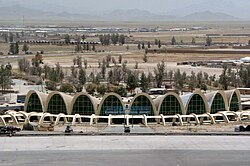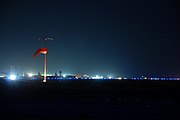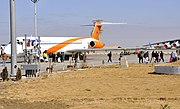| Kandahar International Airport Pashto language: د کندهار نړیوال هوایی ډګر | |||
|---|---|---|---|

| |||
| Aerial view of Kandahar Airport in 2005 | |||
| IATA: KDH – ICAO: OAKN
| |||
| Summary | |||
| Airport type | Public/Military | ||
| Owner | |||
| Operator |
| ||
| Serves | Southern Afghanistan | ||
| Location | Kandahar | ||
| Elevation AMSL | 3,330 ft / 1,015 m | ||
| Coordinates | 31°30′26.0″N 65°51′1.0″E / 31.50722°N 65.85028°ECoordinates: 31°30′26.0″N 65°51′1.0″E / 31.50722°N 65.85028°E | ||
| Runways | |||
| Direction | Length | Surface | |
| ft | m | ||
| 05/23 | 10,498 | 3,200 | Paved |
| Helipads | |||
| Number | Length | Surface | |
| ft | m | ||
| 5L/23R | 1,214 | 370 | Paved |
| Source: Landings.com[1] | |||
Kandahar International Airport (referred to by the U.S. military as Kandahar Airfield, KAF) (IATA: KDH, ICAO: OAKN) is located 10 miles (16 kilometers) south-east of Kandahar City in Afghanistan. It serves as the nation's second main international airport and as one of the largest military bases, capable of housing around two hundred military aircraft. The airport was built in the 1960s by the United States. It was occupied by the Soviets during the 1980s Soviet war in Afghanistan. Following their withdrawal the airport remained in control of Najibullah's government until he stepped down in 1992. Local warlord Gul Agha Sherzai was in charge of the airport until the Taliban took control of Kandahar in 1994. They were driven out of the country during Operation Enduring Freedom in late 2001. The airport was damaged by U.S. and British bombings in October 2001.
As of 2007, the airport has been repaired and expanded. It is used for both military and civilian flights.[2] Most of the airport is maintained by the U.S. Armed Forces and the International Security Assistance Force (ISAF), who have large military bases there. The Afghan Armed Forces also has a separate base there. A smaller portion of the airport is used by the 2nd Wing of the Afghan Air Force. The Afghan National Police provides security inside the passenger terminal.
It is sometimes difficult to locate the airport from the sky during day-time because of a lack of contrast with the ground and the usual dust or haze in the area. But during the night the runway is well lit up and can easily be spotted because it is isolated from the population area.[citation needed]
History[]
Construction (1956-1962)[]
The airfield itself was built between 1956 and 1962 by American consultants, for a cost of US$15 million. Bearing a great resemblance to typical U.S. architecture of the time, its original purpose was as a refueling stop for long-range piston engined aircraft traveling between the Middle East and Southeast Asia. However, with the advent of jet aircraft, such stops were no longer necessary, and the airport saw little use.[3] Since the airport was designed as a military base, it is likely that the United States intended to use it in case there was a show-down of war between the United States and former USSR. While the United States was busy building Kandahar International Airport, the USSR was busy in the north building Kabul International Airport.[4]
Soviet era[]
During the Soviet occupation of Afghanistan, the airfield was used intensively by the Soviet Air Forces, both as logistical facility for flying in troops and supplies and as a base for launching airstrikes against local Mujahideen groups.[5] Fighting in the Kandahar area was particularly intense. However, Kandahar airport was left relatively untouched and its main building was largely intact at the end of the war. The airstrip did suffer extensive damage that was subsequently repaired by the United Nations in the mid 1990s to support humanitarian flights.
Taliban era[]
The airport was mostly used at this time for military and humanitarian purposes, hosting regular flights of the United Nations and the International Committee of the Red Cross to and from Kabul, Jalalabad, Herat and Peshawar (Pakistan). Ariana Afghan Airlines (the national carrier of Afghanistan) also flew infrequent flights out of Kandahar to Pakistan and a few locations in Afghanistan (Herat, Kabul, Jalalabad). The airport came into the public eye during the tense drama that was played out when Pakistani terrorists belonging to Harkat-ul-Mujahideen, who hijacked and landed Indian Airlines Flight 814 on the airfield in December 1999, ordered the Government of India to ensure the release and safe-passage of three alleged Pakistani terrorists in return for letting the occupants of the passenger plane leave without harm. Although the exact nature of the deal that was struck between the Government of India and the hijacking group is not known at this point, it did secure the release of the 3 prisoners who were being held in a prison in India.
NATO mission and the Karzai administration[]

The airport's main terminal in 2002.

Night view of Kandahar Airport in 2007.
During Operation Enduring Freedom in late 2001, Kandahar Airport was one of the first coalition bases established in Afghanistan. It was secured by the Light Armored Reconnaissance element of the US Marines 15th MEU in mid-December 2001, just a few weeks after the first coalition footprint was established at Camp Rhino in the desert to the southwest. The airport was captured by an air insertion coinciding with a rapid overland push from troops based at Camp Rhino. Major battles between the Taliban and local anti-Taliban forces had been fought at the airport just days earlier, and when coalition troops arrived there were abandoned weapons - including a BM-21 still loaded with rockets - scattered around the terminal. Australian and Canadian special forces were amongst the first coalition troops to relocate to Kandahar Airport, and by Christmas Day the US-led coalition had established a footprint of at least 1,000 troops. A perimeter was quickly secured around the terminal building and airstrip, and initially all troops worked and lived in and around the main terminal building itself. The first spartan ablutions were established in the middle of a large rose garden out front, but shower facilities were not established for several weeks. By mid-January 2002, the 101st Airborne Division and Canadian Forces started building up at Kandahar Airport, allowing the 15th MEU to depart. The accommodation area began to enlarge down along the airfield to where the current military base is located, and by April the coalition presence had expanded to several thousand personnel.
The 159th Combat Aviation Brigade became the main U.S. Army Aviation unit at the airport while the 451st Air Expeditionary Wing became the main USAF unit. As part of Operation Enduring Freedom, the Royal Air Force and Royal Navy also had based a squadron of Harrier GR7A aircraft at Kandahar Airfield to provide close air support to coalition ground forces.[6] After June 2009 they were replaced by a squadron of Panavia Tornado GR4 aircraft, carrying out close air support and recce misions. The Royal Air Force also has based a detachment of C130 K and J model Hercules transport aircraft from 24, 30, 47 and 70 Squadrons and its attached Engineering detachment from 24/30 and 47/70 Engineering Squadrons RAF Lyneham. Eight F-16 close air support fighters of the Royal Netherlands Air Force were deployed to Kandahar Airfield to support the expanded NATO operation in southern Afghanistan in late 2006.

Inside the air control tower.
The Afghan government has been slow in rebuilding the facility, the vast majority of it has been reclaimed from years of neglect and damage by Soviet and Taliban soldiers. The interior gardens, pools, kitchen galley, restroom facility, and ticketing areas have been restored. With the transition of the U.S. passenger area terminal to the Afghans in 2005, the airport began to be used for civilian flights. It was used for the 2006 Hajj by Muslim pilgrims. With the closure of Camp Julien in Kabul in November 2005, most of the Canadian Forces personnel in Afghanistan were transferred to Kandahar province. Canadian Brigadier-General David Fraser took command of the multinational brigade from its headquarters at Kandahar Airfield (KAF) in March 2006. At the same time, Canada also fielded a battle group for two successive six-month rotations, and deployed a new rotation for the Provincial Reconstruction Team (PRT) at Camp Nathan Smith in Kandahar.

U.S. Air Force A-10C Thunderbolt II aircraft from the 354th Expeditionary Fighter Squadron taxi at the airport in 2010.

An Afghan Air Force C-27 Spartan warms up its engine on the ramp at Kandahar in 2011. The plane was getting ready to fly back to Kabul International Airport.
The deployments in February 2006 brought Task Force Afghanistan in Kandahar to about 2,250 personnel. The mission of TFA was to improve the security situation in the southern areas, and play a key role in the transition from the U.S.-led multinational coalition to NATO leadership. This change was made in southern Afghanistan in the summer of 2006.[7]
Since 2007, the airport is maintained by NATO under the International Security Assistance Force (ISAF) banner, although a prominent base for the US and Canadian Forces, many other Armed Forces are based there.[8] British Forces use Kandahar as their main staging post for the south and fly direct into the Helmand province. Fast jets and combat helicopters are also deployed as this is the main airport in the south of the country. NATO operates a major trauma hospital at the base, treating battle casualties, including Afghan civilians and enemy forces.[9]
In July 2007, the post of Commander, Kandahar Airfield (COMKAF) was created as a NATO appointment which, until recently, has been held by an officer of the Royal Air Force of OF-6 rank.
Commander, Kandahar Airfield has been held by:
- July 2007 - Air Commodore A D Stevenson [10]
- February 2008 - Air Commodore R W Judson (exact date unknown)
- September 2008 - Acting Air Commodore A D Fryer [11]
- July 2009 - Air Commodore M A B Brecht [12]
- May 2010 - Air Commodore G Moulds [13]
- November 2010 - Brigadier General Jeffrey Kendall [14]
- November 2011 - Brigadier General Scott Dennis
- November 2012 - Brigadier General John Dolan

A 12 Squadron Royal Air Force Tornado GR4 taxis out towards the runway.
No. 904 Wing RAF is stationed at the airport. The 2009 surge in NATO operations in southern Afghanistan pushed the number of aircraft operations at the base from 1,700 to 5,000 flights a week. The numbers meant that Kandahar had become the busiest one-runway airport in the world.[15]
According to OSGEOINT, imagery analysis shows 2 deployments of unmanned aerial vehicles on the northeast section of the airfield. These two deployments were current as of 2012 and consisted of four MQ-1 Predators and four MQ-9 Reapers with the associated support equipment. These drones support the targeting mission in the Pakistan-Afghanistan region where the US seeks to kill those associated with the insurgency, and those with ties back to other areas the US has a presence (e.g. Yemen, Saudi Arabia, Somalia). As of January 2012, Kandahar Airfield oversees a population of roughly 26,000 personnel. The airport is slowly being expanded by the United States Army Corps of Engineers with new facilities being added for the Afghan National Security Forces (ANSF), particularly the Afghan Air Force (AAF).
Airlines and destinations[]

A Kam Air passenger plane at Kandahar International Airport in 2012
| Airlines | Destinations |
|---|---|
| Ariana Afghan Airlines | Kabul, Dubai, Delhi |
| Gryphon Airlines | Dubai, Kuwait [16] |
| Iran Aseman Airlines | Tehran [17] |
| Kam Air | Dubai, Kabul, Mazar-e-Sharif |
Cargo[]
| Airlines | Destinations |
|---|---|
| Coyne Airways | Dubai |
| Daallo Airlines | No fixed destinations[18] |
| FitsAir | Dubai |
| Kalitta Air | Bahrain, Hong Kong, New York [19] |
| Silk Way Airlines | Baku [20] |
See also[]
- List of airports in Afghanistan
- Bagram Air Base
References[]
- ↑ Airport record for Kandahar International Airport at Landings.com. Retrieved 2013-8-1
- ↑ Pajhwok Afghan News (PAN) - AAA begins flights for Kandahar. November 30, 2007.
- ↑ Kaplan, Robert(2001); Soldiers of God: With Islamic Warriors in Afghanistan and Pakistan; Vintage Departures; ISBN 1-4000-3025-0, pp.185-186
- ↑ In Small Things Remembered - The Early Years of U.S.-Afghan Relations
- ↑ Kaplan, p.186
- ↑ MOD... Link
- ↑ www.centcom.mil - Canada
- ↑ http://exitstrategyafghanistan.blogspot.com/2013/03/month-7-day-3.html
- ↑ Reilly, Corinne, "Near Afghanistan’s front lines, a daily fight for life", Norfolk Virginian-Pilot, 31 July 2011.
- ↑ Royal Air Force Air Rank Appointments List 2/07 retrieved 21 February 2007
- ↑ Royal Air Force Air Rank Appointments List 04/08 retrieved 9 June 2008
- ↑ Royal Air Force Air Rank Appointments List 3/09 retrieved 8 April 2009
- ↑ Royal Air Force Air Rank Appointments List 1-10 dated 3 Mar 10
- ↑ RAF News by date: UK hands over command of Kandahar airfield retrieved 16 Jan 11
- ↑ Gertz, Bill, "Inside The Ring: Record Afghan air traffic", Washington Times, July 2, 2009, p. B1.
- ↑ Gryphon Airlines | Serving the African, Middle Eastern, European and South Central Asian regions
- ↑ No Operation
- ↑ Air Cargo World Index
- ↑ Kalitta routes
- ↑ Silk schedule
External links[]
| Wikimedia Commons has media related to Kandahar International Airport. |
- Kandahar Airfield
- Kandahar Airfield Information
- Airport record for Kandahar International Airport at Landings.com
- Current weather for OAKN at NOAA/National Weather Service
The original article can be found at Kandahar International Airport and the edit history here.
